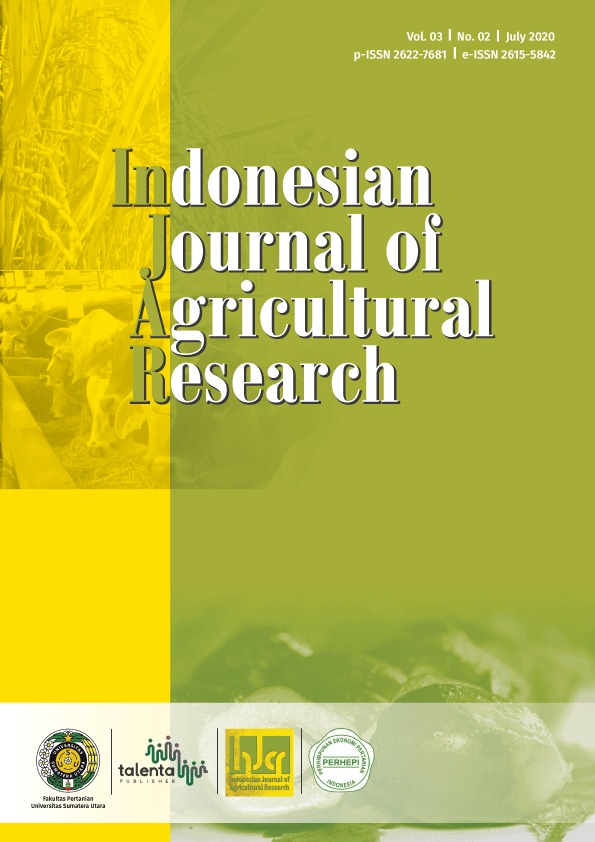Utilization of Blood Meal, Slaughterhouse Waste and Bio Gas Slurry into Fertilizer
DOI:
https://doi.org/10.32734/injar.v3i2.4267Keywords:
blood meal, C/N, organic fertilizer, slaughterhouse waste, slurryAbstract
In slaughterhouses the burden of waste such as excessive blood volume causes waste process with sewage treatment pond cannot work optimally. Blood should be separated and processed into other products such as blood meal. This study aims to prove that addition of blood meal produces good quality organic fertilizer. In this research, the fermentor used in the composting process was biogas slurry. The study used CRD (Complete Randomized Design) with 4 treatments: without blood meal; blood meal 6.5%; blood meal 13% and blood meal 19.5%. There was no difference between the treatments at fertilizer temperature, pH and C/N except treatment 19.5% blood meal on C/N. Application of blood meal by 19.5% in the fourth week on C/N was 12.17 as a requirement for mature fertilizer. The treatment by adding 375 g blood meal on 6 kg livestock feces and 6 kg feed leftover while use biogas slurry as the fermentor was a novel organic fertilizer formula.
Downloads
References
Dinas Ketahanan Pangan dan Peternakan Propinsi Sumatera Utara, “Buku Statistik Peternakan Tahun 2019,†Medan, Indonesia, 2019.
F. R. Spellman and R. Frank, Handbook of water and wastewater treatment plant, Library of Congress Cataloging-in-Publication Data, 2003.
F. Yunta, Michele Di Foggia, Violeta Bellido-Dıaz, Manuel Morales-Calderon, Ì Paola Tessarin,Sandra Lopez-Rayo, Anna Tinti,Krisztina Kovacs, Zoltan Klencsa Ìr, Ferenc Fodor,and Adamo Domenico Rombola, “Blood Meal-Based Compound. Good Choice as Iron Fertilizer for Organic Farmin,†Journal of Agricultural and Food Chemistry, vol 61. 3995-4003, 2013.
M. Roy, Sukalpa Karmakar, Anupam Debsarcar, Pradip K Sen and Joydeep Mukherjee, “Application of rural slaughterhouse waste as anorganic fertilizer for pot cultivation ofsolanaceous vegetables in India,†International Journal of Recycling of Organic Waste in Agriculture, A Springer Open journal, 2:6, 2013.
Y.W. Jeon, H. J. Kim, Y. H. Cho, and H. M. Yoo, “Biological Conversion from Slaughter Blood into Amino Acid Liquefied Fertilizer,†International Journal of Environmental Science and Development, vol. 4, no. 5, pp. 509-513, 2013.
Peraturan Menteri Pertanian Nomor 70 Tahun 2011, “Tentang Pupuk Organik Pupuk Hayati dan Pembenahan Tanah,†Jakarta, Indonesia, 2011.
T. P. Souza, L. M. A. Soares, C. P. deCastro, E. S. Dias, “Microbial Additives in the Composting Process,†Cienc.agrotec, vol. 41 no. 2 Lavras Mar/Apr. 2017, doi: 10.1590/1413-70542017412038216
M. Krzymien, M. Day, K. Shaw, and L. Zaremba, “An investigation of odors and volatile organic compounds released during composting,†Journal of the Air & Waste Management Association, vol. 49, pp. 804-813, 2011.
E. G. Khater, “Chemical and Physical Properties of Compost,†2012. [Online]. Available: https://www.researchgate.net/publication/275153175
K. Shrestha, P. Shrestha, K. Walsh, and K. M. Harrower, “Microbial enhancement of compost extracts based on cattle rumen content compost - Characterisation of a system,†Bioresource Technology, vol. 102, no. 17, pp. 8027-34, doi: 10. 1016/j.biortech.2011.06.076.
C. S. Steward, “The Rumen Bacteria. Rumen Microbial Metabolism and Ruminant Digestion,†Institute National De La Rocherche Agronomique, 1991.
N. Ginting, Hasnudi, Yunilas, and M. A. Purba, “Microbial effects from biogas slurry application on growing phase of turi (Sesbania grandiflora),†Jurnal Peternakan Integratif, vol. 7, no 2. pp. 1-9, 2019.
A. Yitayal, D. Mekibib, and A. Araya, “Study on biogas production potential of leaves of justicia schimperiana and macro-nutrients on the slurry,†International Journal of Waste Resurces, vol. 7, no. 3, 1000294, 2017, doi: 10.4172/2252-5211.1000294.
K. Somjai and S Nissaikla, “Effects of mcrobial inoculation on composting of household organic waste using passive aeration bin,†International Journal of Recycling of Organic Waste in Agriculture, vol. 3, pp. 113-119, 2014.
L. M. Brito, J. Coutinho, and S.R Smith, “Methods to improve the composting process of the solid fraction of dairy cattle slurry,†Bioresource Technology, vol. 99, pp. 8955-8960, 2008.
M. M. Smith, J. D. Aber, and R. Rynk, “Heat recovery from composting: A comprehensive review of system design, recovery rate and utilization,†Journal Compost Science & Utilization, vol. 25, issue sup 1, 2017.
R. F. Ramadhan, Y. Marlida, Mirzah, and Wizna, “Metode pengolahan darah sebagai pakan unggas,†Jurnal Peternakan Indonesia, vol 17, no. 1, pp. 63-76, 2015.
O. Imanudin and D. Widianingrum, “Feces bioconversion of broiler chicken feeding containing red guava waste as feed additive,†Jurnal Peternakan Indonesia, vol. 20, no.1, pp. 42 – 51, 2018.
A. J. Ward, P. J. Hobbs, P. J. Holliman, and D. L. Jones, “Optimizationof the anaerobic digestion of agricultural resources,†Biores Technol, vol 99. no.17, pp. 7928-7940, 2008.
W. M. Nada, “Stability and maturity of maize stalks compost as affected by aeration rate, C/N ratio and moisture content,†Journal of Soil Science and Plant Nutrition, vol.15, no. 3, 2015, doi: 10.4067/SO718-95162015005000051
Sutedjo and Mul Mulyani, Pupuk dan Cara Pemupukan. Jakarta: PT. Asdi Mahasatya, 2002.
J. W. C. Wong, A Selvam, Z Zhao, O P. Karthikeyan, SMYu, A.C.W. Law, and P C.P Chung, “In-vessel co-composting on horse stable bedding waste and blood meal at different C/N ratios: Process Evaluation,†Environmental Technology, vol. 33, no. 22-24, pp. 2561-2567, doi:10.1080/09593330.2012. 679697
M. A. Macias–Corral, J. A. Cueto-Wong, J. Moran-Martinez, and L. Reynoso-Cuevas, “Effect of different initial C/N ratio of cow manure and straw on microbial quality of compost,†International Journal of Recycling of Organic Waste in Agriculture, vol. 8, pp. 357-365, 2019.
Downloads
Published
How to Cite
Issue
Section
License
Copyright (c) 2020 Indonesian Journal of Agricultural Research

This work is licensed under a Creative Commons Attribution-ShareAlike 4.0 International License.



















